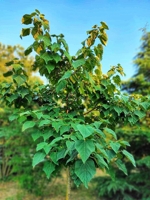Mon-Fri 9am - 5pm Mountain time
Northern Red Oak vs Empress Tree
Quercus rubra
Paulownia tomentosa
Northern Red Oak is a medium-sized deciduous tree. It is fast-growing (for an oak tree) and is used primarily in lawns, parks, golf courses, street-side plantings, and commercial areas. Northern Red Oak's fall color is spectacular.
In open spaces, it has a short, massive trunk and an extensive crown. In forests Northern Red Oak grows with a tall columnar bole and small rounded head.
We are one of the only nurseries growing this tree.
Check out some video of the spectacular fall colour on our Northern Red Oak seedlings just before harvest on our YouTube Channel.
Note: Most Oak species can be considered toxic for many animals.
The Empress Tree is a fast growing, ornamental shade tree. It has purple, fragrant flowers that are quite attractive. The flowers emerge before the leaves in early spring. The leaves of this tree can grow very large, up to 30 cm long.
As one of the fastest growing trees in the world, this tree has been given considerable attention for carbon sequestration projects. It drops many seeds which can make it invasive in warmer climates. Please do some research and plant the right tree in the right place.
The Empress tree’s genus name comes from Princess Paulowna, daughter of Tsar Paul I of Russia.

